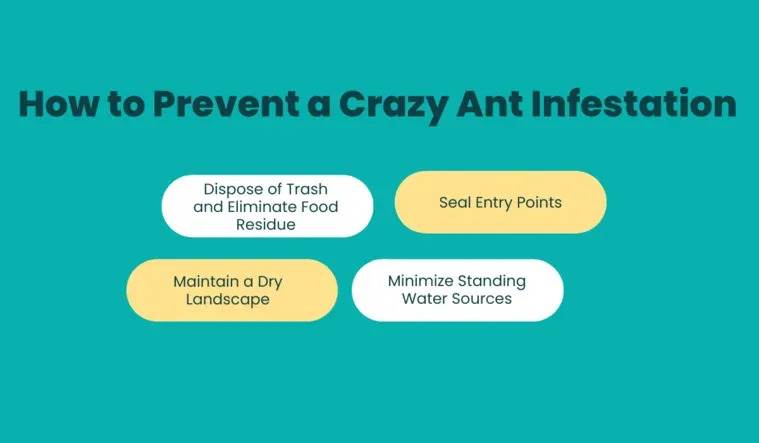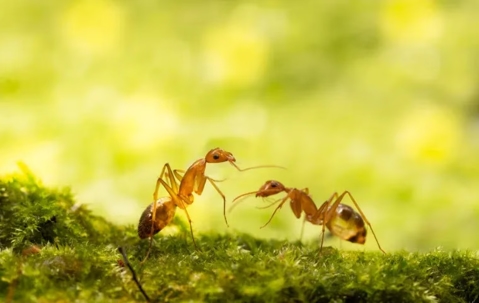Identifying Crazy Ants in Miami, FL
Miami is facing a growing concern with the invasion of crazy ants, an invasive species that thrive in the region's warm climate.
These ants, known for their erratic movements and tendency to form large colonies, have become a significant issue for homeowners and environmentalists alike.
Think you might have a crazy ant infestation? Keep reading to learn how to identify crazy ants, at home control methods and prevention, and when to call a professional exterminator.
Key Takeaways
- Crazy ants pose a significant challenge for residents and environmentalists in Miami.
- A strategic approach is necessary to manage the environmental impact of crazy ants effectively.
- Professional pest control services are more equipped to handle extensive crazy ant infestations than DIY methods.
How to Identify Crazy Ants in Florida
Crazy ants have become a significant concern in Florida, impacting both ecological balance and human habitations.
Species Profile
Known for their erratic foraging patterns and large ant colonies that can quickly overrun an area, crazy ants have two variations in Florida. Here’s how you can distinguish the two.
Feature | Crazy Ant | Tawny Crazy Ant |
Scientific Name | Paratrechina longicornis | Nylanderia pubens |
Color | Dark brown to black | Reddish-brown |
Body Hair | Less notable | Hairy |
Antennae or Legs | Long | Long |
Size of Worker Ants | 2.5 to 3 mm | 2 to 3 mm |
Movement | Rapid, erratic | Rapid, erratic |
How Do Crazy Ants Compare to Other Ant Species?
Understanding these differences is crucial for effective pest control. Here's how crazy ants stack up against other common ant species:
- Ghost Ants: Pale, small, and prefer sweets. Nest indoors, especially in moist areas, unlike the more aggressive and versatile crazy ants.
- Big-Headed Ants: Notable for their large heads and preference for proteins and fats, contrasting with crazy ants' varied diet and aggressive foraging.
- Carpenter Ants: Larger, cause structural damage by nesting in wood, unlike the non-wood damaging, nomadic crazy ants.
- Argentine Ants: Like crazy ants, they form supercolonies but prefer sweeter foods and indoor habitats, whereas crazy ants adapt to various environments.
- Caribbean Crazy Ants: Similar invasive behavior to crazy ants but with darker coloration. Both species form massive colonies and are difficult to control.
- Imported Fire Ants: Aggressive, inflict painful stings, and prefer open areas. They are more territorially limited than the ubiquitous crazy ants.
- Sugar Ants: Smaller, less aggressive, and attracted to sugary substances. Crazy ants have a broader diet and are more invasive.
How Do Crazy Ants in Miami Behave?
Miami residents like you often encounter a variety of household pests like roaches, mealybugs, and termites, but crazy ants present unique challenges due to their unpredictable behavior and adaptability.
Below is the outline of key aspects of crazy ants to help you recognize them from other tiny ant species.
- Adaptability: Crazy ants thrive in a variety of habitats, including soil, leaf litter, and potted plants, showcasing their high adaptability.
- Foraging Behavior: Their foraging is unpredictable, with the ability to form super-colonies that extend across vast areas, making their behavior a notable challenge.
- Nesting Preferences: Locating nesting sites can be difficult, as crazy ants prefer concealed spots beneath objects or in other hidden locations.
- Urban Nuisance: In urban settings, they often invade homes and businesses, especially electrical equipment, posing a risk of damage.
Distribution and Spread
As a resident of Miami, understanding the origins, distribution, and challenges crazy ants pose is crucial for effective ant control and prevention.
Distribution | Details |
Origin | South America or similar tropical regions |
Presence in the U.S. | Established populations in multiple Florida counties (Miami-Dade, Broward, Hillsborough, Sarasota) and as far north as Georgia. |
Other States in the U.S. | Found across the Southern United States, such as Texas. |
Factors Contributing to Rapid Spread
- Transportation: Frequently moved via landscaping materials and potted plants.
- Sustenance: Ability to exploit honeydew from aphids and other insects supports large populations.
- Challenges in Control: The large populations increase the difficulty of management in infested areas.
Why is Miami a Hotspot for Crazy Ants?
Nestled in the heart of South Florida, Miami is a vibrant city known for its sunny skies, lush landscapes, and dynamic culture.
This perfect environment provides a breeding ground for various invasive species, with crazy ants posing a significant threat to the local ecosystem and residential peace of mind.
- Warm Climate & High Humidity: Creates an ideal environment for crazy ants to thrive and multiply rapidly.
- Bustling Port Activity: Increases the risk of new infestations via imported goods and materials.
- Diverse Habitats for Nesting: Provides ample opportunity for crazy ants to spread From electrical equipment to underbrush.
Impact on Local Ecosystem
Crazy ants in Miami's ecosystem wreak havoc on the natural balance. Here’s how they do so:
- Displace Native Species: Crazy ants outcompete native ant species for resources.
- Disrupt the Food Chain: Preying on small invertebrates and reducing beneficial insect populations affects gardens and crops.
- Farm on Aphids: This feeding behavior can exacerbate the spread of plant diseases, posing a further threat to biodiversity.
How Do Crazy Ants Impact Us?
In the bustling communities of South Florida, you may face crazy ants once in your life. These invasive insects not only challenge local ecosystems but also pose direct threats to your daily lives and homes.
Aspect
Impact
Household Damage
- Invade homes in large numbers.
- Attracted to electrical equipment, causing short circuits.
- Nests often found in debris, challenging to manage due to high numbers.
Economic Considerations
- Represent a significant economic burden for ongoing pest management.
- Replacement costs for damaged items.
- Increase in other pest populations due to their attraction to honeydew.
Do Crazy Ants Pose Any Health Risks?
Crazy ants can still pose indirect health risks, especially when they invade spaces in large numbers.
Here are the key points to consider:
- Skin Irritation: Crazy ant bites may cause skin irritation or minor allergic reactions in sensitive individuals. The bite itself might not be as painful as those from other ant species, but the discomfort can be noticeable, especially with multiple bites.
- Venom: Unlike some other ants, the venom of crazy ants is not known for causing severe reactions in humans. However, any form of ant bite can lead to secondary infections if the bite area is not properly cleaned and cared for.
- Psychological Stress: The presence of large numbers of crazy ants can also lead to psychological stress and anxiety. Dealing with an ant infestation can be overwhelming and may affect the well-being of individuals, especially those with a phobia of insects.
How to Prevent a Crazy Ant Infestation
Understanding the importance of both sanitation and environmental management is the first step in keeping these unwelcome guests at bay.
Here’s how to keep your home clean in the fight against crazy ants:
Dispose of Trash and Eliminate Food Residue
- Regularly remove trash, sweep off dead insects, and wipe away food spills to significantly reduce the likelihood of an ant invasion.
- Ensure kitchen surfaces and dining areas are clean, and store food in airtight containers to remove any attractants that might lure ants indoors.
Seal Entry Points
- Inspect your home for any potential entry points that crazy ants could use to gain access, such as wall voids.
- Focus on sealing cracks in the foundation, gaps around windows and doors, and any other small openings you find in the baseboards.
- Use silicone-based caulk or weather stripping to block these entrances effectively.
Maintain a Dry Landscape
- Repair any leaky faucets, hoses, or irrigation systems promptly.
- Ensure that your home's drainage systems are functioning correctly, directing water away from your house to prevent accumulation.
- Consider landscaping options that promote good drainage and reduce moisture retention in soil near your home.
Minimize Standing Water Sources
- Take steps to minimize standing water around your property, including emptying pet bowls when not in use and drilling drainage holes in flower pots.
- Consider adjusting landscaping practices to eliminate water accumulation in your yard, such as avoiding overwatering plants and ensuring gutters and downspouts are clear and functional.
How to Get Rid of Crazy Ants in Florida
When addressing the control of crazy ants in Miami, FL, you may face a choice between professional pest management services and attempting do-it-yourself (DIY) solutions.
Immediate DIY Actions
- Seal entry points: Inspect your home for any cracks or crevices and seal them with silicone caulk to prevent ants from entering.
- Remove attractants: Keep your kitchen and dining areas clean. Store food sources in sealed containers and manage garbage regularly so as not to attract ants.
- Use natural deterrents: Apply vinegar, lemon juice, or peppermint oil around entry points. These natural repellents act as an insecticide that can deter ants without harming your family or pets.
Targeted DIY Solutions
- Boric acid bait: Mix boric acid with a sweet substance, like sugar water or honey, to attract and poison crazy ants. Place the ant bait near ant trails but out of reach of children and pets.
- Diatomaceous earth (DE): Sprinkle food-grade diatomaceous earth around the perimeter of your home. DE works as a desiccant, drying out the ants' exoskeletons and killing them.
- Soap and water spray: A mixture of soap and water can kill ants on contact. Spray it directly on ants and their pheromone trails to disrupt their pathfinding.
While DIY solutions often seem like a cost-saving measure, without proper knowledge and tools, they might be more expensive in the long run if the ant problem persists.
That’s where investing in a professional pest control company could result in more effective and sustainable management.
When to Call a Pest Control Professional
Contending with crazy ants in Miami? Consult with professional pest control services, such as those at Native Pest Management.
They can provide valuable insight after a free inspection into the extent of an infestation and suggest the best course of action, whether it is a professional service or guidance for a more effective DIY approach to achieving a pest-free home.
